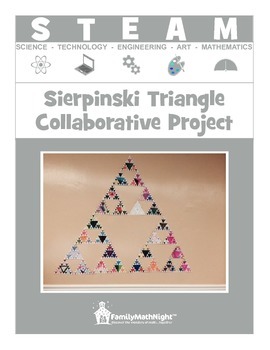STEAM: Sierpinski Triangle Collaborative Project
- PDF
Description
Get kids excited about science, technology, engineering, art, and mathematics (STEAM) with this fun hands-on collaborative project. Typically done during a Family Math Night event, this project can also be done in the classroom. The best part is, each person is individually represented in the final product!
The project includes three activity levels all which result in creating self-similar triangles which are then put together to make the large Sierpinski Triangle. Focusing on fractals (self-similarity), students will learn about the Father of Fractal Geometry, Benoit Mandlebrot, Chaos Theory, and the connection between fractals and our cell phones.
Included in the lesson plan
• list of materials needed
• mathematical background
• mathematical vocabulary
• table tent with step-by-step directions
• Sierpinski Triangle: A Fractal Activity, beginning level
• Sierpinski Triangle: A Fractal Activity, intermediate level
• Sierpinski Triangle: A Fractal Activity, advanced level
• Beginning, Intermediate, and Advanced table tents
• link to the video version of the lesson
More great STEAM and FAMILY MATH NIGHT Collaborative Projects
If you're interested in other ideas for your Family Math Night events, I have a lot of them! Check out my blog, pinterest page, website or YouTube Channel. And if you have questions, let me know!
Family Math Night YouTube Channel
Wishing you a successful Family Math Night event!
Karyn
karyn@FamilyMathNight.com





